Different Types Of Ankle Sprains, Symptoms & Treatment Options
Ankle sprains are common injuries and although they are often thought of as sports injuries, they are quite common in non-athletes and in people of all ages. A study into the incidence and prevalence of Ankle Sprains showed that ankle sprains occur more in children as compared to adolescents and adults, and in more females as compared to males (1).
In terms of sports, the ankle is the second most-likely joint to be injured (2). Further studies show that ankle sprains occur most commonly while playing indoor sports, the most common of which is Basketball.

Table Of Contents:
2. What Happens When You Have An Ankle Sprain?
3. Treatment and Recovery From An Ankle Sprain
What is an Ankle Sprain?
An ankle sprain is an injury that results from the twisting or rolling of the ankle in the wrong manner. Most ankle sprains occur when you make a sudden misstep, twist your foot while walking or running, or when you land awkwardly on your foot after jumping or turning. Inappropriate movement of the ankle can allow the tough bands of fibrous tissues -- which we call ligaments – that hold the anklebone in place, to stretch and tear due to the excessive movement. This causes the ligaments to move beyond their normal range of motion. Read our in depth anatomy of the ankle blog post.
How to Identify The Types of Ankle Sprains
The 2 common types of ankle strains are inversion and eversion ankle sprains.
- Inversion sprain: This is the most common out of the two and typically occurs due to the outward rolling of the ankle and the inward turning of the foot. As a result, the outer ligaments (lateral ligament) of the ankle are overstretched and torn.
- Eversion sprain: Sometimes the ankle may roll inward and the foot may turn outward causing an eversion injury. An eversion injury damages the inner ligaments (medial ligament) of the ankle.
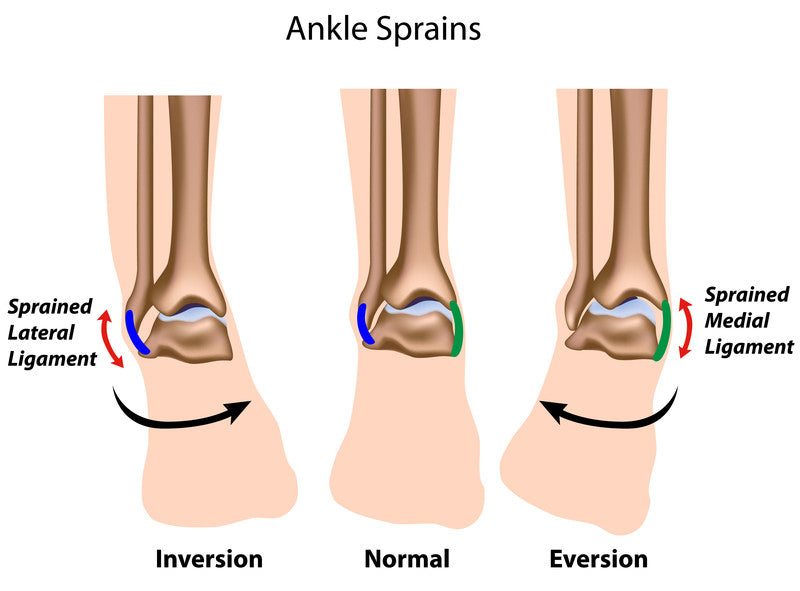
What Happens When You Have an Ankle Sprain?
Have a look at what happens on the inside of your body when you have an Ankle Sprain:
https://www.webmd.com/pain-management/video/inside-ankle-sprain
Causes Of Ankle Sprains
Ankle sprains occur when a movement forces the ankle to budge from its original position, causing one or more ligaments to stretch or tear, such as:
- Landing incorrectly on the foot after jumping
- Walking or running on uneven surfaces
- A fall that may cause the ankle to twist
Ankle sprain symptoms
- Pain and swelling while walking or when performing other weight-bearing activities
- Bruising and tenderness
- Restricted range of motion
- A ‘pop’ or snap sound upon the onset of the injury
The 3 Grades of Ankle Sprains
Ankle Sprains are graded to determine how severe they are and what sort of medical attention you will need:
-
Grade 1 sprain: This is very mild and no disability occurs. It is a minor strain of one or more ligaments with no tearing. You can perform daily life activities. The injury usually takes 2 to 3 weeks to recover.
-
Grade 2 sprain: This is a moderate injury that may cause discomfort. It occurs when there is a partial tear of one or more of the ligaments. Activities such as twisting of the ankle may have to be limited. The injury takes 3 to 6 weeks to recover.
- Grade 3 sprain: This is a very severe injury that may cause a lot of discomfort and pain. It occurs when there is a complete tear of one or more of the ligaments. The injury may take 3 months to heal.

Treatment and Recovery from an Ankle Sprain
When You Should Seek Medical Attention
 Treatment for ankle sprain normally depends on how severe the damage is. If the ankle sprain is a minor one, you can use the P.R.I.C.E. Method and over-the-counter medication to help with pain relief and tough it out until such time the pain goes away on its own. This usually takes a few days before you can get back on your feet and continue with daily life.
Treatment for ankle sprain normally depends on how severe the damage is. If the ankle sprain is a minor one, you can use the P.R.I.C.E. Method and over-the-counter medication to help with pain relief and tough it out until such time the pain goes away on its own. This usually takes a few days before you can get back on your feet and continue with daily life.
You can also make use of any one of our Ankle Braces to help support your ankle while you heal:
However, if the sprain persists for more than a few days and causes more than manageable pain, swelling, or difficulty walking, you should consult your doctor.
In the case of a moderate to severe ankle sprain, your ankle may heal poorly and you could develop lasting decreased range of motion or instability if you don’t get the proper diagnosis, treatment, and rehabilitation. This can lead to chronic pain and recurrent sprains in the future.
It’s even more important for you to always seek medical attention if you’re an athlete because an untreated ankle sprain can severely inhibit your sports performance, especially in the long term.
Phases of Healing and Recovery from an Ankle Sprain
- Acute or Inflammatory Phase
- Phase 1 of Ankle Rehabilitation
- Phase 2 of Ankle Rehabilitation
- Advanced Rehabilitation Phase
1. Acute or Inflammatory Phase (0 -3 days)
Immediately following the injury, the primary goal is to decrease pain and swelling and safeguard the ankle from further injury. The P.R.I.C.E. Method is the safest and most commonly recommended regimen worldwide for acute soft tissue injuries, especially if you don’t have access to medical care immediately. It’s also recommended in this phase because it helps you heal faster and gives you more flexibility while you do so.
The P.R.I.C.E. Method (3):
- Protection: First and foremost, it’s important to prevent the affected area from any further injury. Your doctor or physical therapist will recommend a brace or boot depending on the severity of the sprain.
- Rest: It is important to avoid any type of physical activity that may add to your pain or swelling. However, it is recommended that you do not avoid all types of activity. Your foot requires enough rest to alleviate your symptoms, but you can still exercise other muscles of your body. You can perform low-impact activities such as swimming or cycling that involve movement of your arms and unaffected leg.
- Ice: Before seeking medical help, it’s important that you apply an ice pack right after the injury. Do this for 10-20 minutes, every 2 to 3 hours of the day. Cold compresses help in reducing pain, swelling, and inflammation of the joint.
*If you have a chronic condition such as cardiovascular disease, diabetes, or suffer from altered sensation, speak with your doctor before applying ice.
-
Compression: Compress the affected ankle with an elastic band to reduce swelling. You can also consider taping for the same purpose. Compression works by reducing the weight on the ankle so that it is effectively mobilized. Avoid wrapping the ankle too tightly to avoid constricting your blood flow. Good circulation and blood flow are important so that you heal faster. Loosen the wrapping if you feel any pain or numbness of the foot. For mild to moderate ankle sprains, experts recommend using the McDavid Elastic Ankle Sleeve 511 as it provides relief from symptoms. Whereas, for more severe injuries or grade III sprains, the McDavid Ankle Brace With Straps that will prevent greater support and prevention of ankle rolling and recurrence of injury is more suitable.
- Elevation: Keep the ankle elevated at a level above your heart while you rest to encourage circulation and diminish swelling. You can use a few pillows to prop your leg up in a comfortable position on your bed or couch while you rest.
To combine both Ice and Compression of the ankle, we highly recommend our Polar Ice Foot and Ankle Wrap for a comfortable and effective solution for pain management.
See the full version of our R.I.C.E treatment method infographic
Other treatment measures include:
- Medication: During this initial phase, your doctor will prescribe medication to help reduce pain, inflammation, and swelling. If you are unable to see a doctor immediately, over-the-counter medications like ibuprofen or acetaminophen will help manage your pain.
- Physical therapy: Your physical therapist will instruct you to wiggle your toes and move your ankle in small movement ranges that are pain-free so that you maintain good blood flow to the area. Good circulation is optimum for your healing process.
2. Phase 1 of Ankle Rehabilitation (4 - 10 days)
During Phase 1 of your rehabilitation, your physical therapist will start you on the process of rehabilitation and teach you how to slowly increase the function and activity of your ankle with carefully-guided exercises. At this stage of healing, you will gradually put more weight onto your affected ankle and the ankle will need to be strong enough to tolerate it. Therefore, your physical therapist will prescribe exercises that aim to rehabilitate your ankle by improving your:
- Range of motion
- Stability
- Flexibility
- Motor Coordination
The video below is a great guideline for exercises you can do during Phase 1 of your Ankle Rehabilitation.
Exercises for Phase 1 of your Ankle Rehabilitation can be summed up as follows:
- Ankle Alphabets: 2 times a day
- Hamstring/Calf Stretch: Hold the stretch for 30 seconds at a time. Repeat 3 times
- Standing Gastroc Stretch: Hold the stretch for 30 seconds at a time. Repeat 3 times
- Soleus Stretch: Hold the stretch for 30 seconds at a time. Repeat 3 times
- Dorsiflexion on step: 1 set of 30 reps each day
- Ankle 4 Ways: 3 sets of 10 reps in 4 different directions
- Towel curls: 3 sets of 10 reps
- Clamshells: 3 sets of 10 reps
- Single-leg stance: Hold for 30 seconds 3 times
Your physiotherapist may also use bracing or sports tape to support your ankle and reduce pain during this early phase of rehabilitation.
3. Phase 2 of Ankle Rehabilitation (11 - 21 days)
This phase is all about getting you back to normal or regular functioning and activity of the ankle. At this stage of recovery, because your ankle has done a lot of healing, it will most likely have also lost a fair bit of muscle strength and range of motion too. You will be required to fully weight-bear onto your affected ankle and be able to carry loads while doing so.
During this phase, your physical therapist will focus on:
- Improving your muscle strength
- Active stability of your ankle while you do everyday tasks
- Foot and ankle range of motion
- Mobility such as walking, walking up and down staircases, walking up and down inclines, etc.
This phase may also include the use of protective bracing or taping, depending on how you present. The intensity of your rehabilitation program will increase and therefore you will also need to make use of pain management techniques like icing and massage after you do your exercises.
Please watch the video below for a detailed explanation of the exercises needed at this phase in your rehab.
Exercises for Phase 2 of your Ankle Rehabilitation can be summed up as follows:
- Inchworm: 1 set of 5 reps
- Squat to heel raise: 3 sets of 10 reps
- Eccentric calf raises: 3 sets of 15 reps
- Single leg calf raises: 3 sets of 15 reps
- Lateral toe walking: 15 steps to the left, 15 to the right
- Lateral heel walking: 15 steps to the left, 15 to the right
- Forward Lunge: 2 sets of 10 reps on each side
- Side lunge: 3 sets of 10 reps
- Forward and back: 1 set of 20 reps
- Side to side: 1 set of 20 reps
- Forward and back: 2 sets of 10 reps
- Side to side: 2 sets of 10 reps
Most people stop after this phase as they find that they have healed sufficiently and can, therefore, resume their normal daily activities.
4. Advanced Rehabilitation Phase (22 days to full recovery)
Most often this phase applies to high-performance athletes and people who have sustained very severe ankle sprains that required surgery. This is the last and final stage of healing and can take anywhere from 2 - 6 months, and sometimes even longer.
Your compliance with physical therapy and determination to succeed also plays a huge role in your healing. So having a good attitude is necessary for getting you to where you want to be. A great support system from family members and friends is a bonus!
Your physical therapist will work with you to achieve full function and mobility of your ankle for all recreational and sporting activities that apply specifically to you. The aim of rehabilitation at this point is to get you back to where you were before you sustained the injury. In doing so, it will focus on getting you back to full:
- Stability and flexibility
- Range of motion
- Muscle strength
- Speed and endurance
- Balance and co-ordination
You will know that you have healed completely when you are able to get back to your level of performance without any limitations or fear.
Surgery
Ankle sprains often heal on their own or with protective bracing and good guidance from a physical therapist. Surgery is required when:
- The tear is complete and the damage is severe
- Conservative management and rehabilitation is unsuccessful
Your surgeon will inform you of the different options available and together you will decide on the best option for you. Recovery from surgery depends on the severity of the injury and the type
of surgery performed. Your surgeon will let you know what to expect and will most likely have your foot in a cast or surgical boot for up to two months.
Types of Surgical Management for Ankle Sprains
- Ankle Ligament Reconstruction Surgery: This procedure is done to tighten one or more of the ligaments of your ankle that have been overstretched. Its usually done as outpatient surgery and you can go home on the same day (4).
- Tendon Graft: In the case of a complete tear of one or more ligaments where the damage is more severe, your surgeon will need to use a portion of a nearby tendon to surgically attach the ligament in question securely to stabilize the ankle. Your surgeon may also opt to do an Allograft (using the tendon from a cadaver).
- Ankle Arthroscopy: In cases of chronic pain or instability, the surgeon will opt for an Arthroscopy. This procedure involves inserting a small camera into the ankle joint via a small incision to see exactly what’s going on and guide the surgery. It involves removing bone fragments, scar tissue, and damaged cartilage to make the joint move more smoothly without pain (5).
Physical therapy after surgery is vital and recovery will follow the stages as listed above. Every patent is different and therefore so is the healing process. But if you are determined to heal, comply with your treatment protocol and ensure you attend all follow-up appointments with your surgeon and physical therapist, you will be on your way to a full recovery before you know it!
What do you think? Leave a comment below!
Article updated 10th September 2020
References:
- https://pubmed.ncbi.nlm.nih.gov/24105612/
- https://www.physio-pedia.com/Ankle_Sprain#cite_note-2
- https://www.nhs.uk/conditions/sports-injuries/treatment/
- https://www.hopkinsmedicine.org/health/treatment-tests-and-therapies/lateral-ankle-ligament-reconstruction


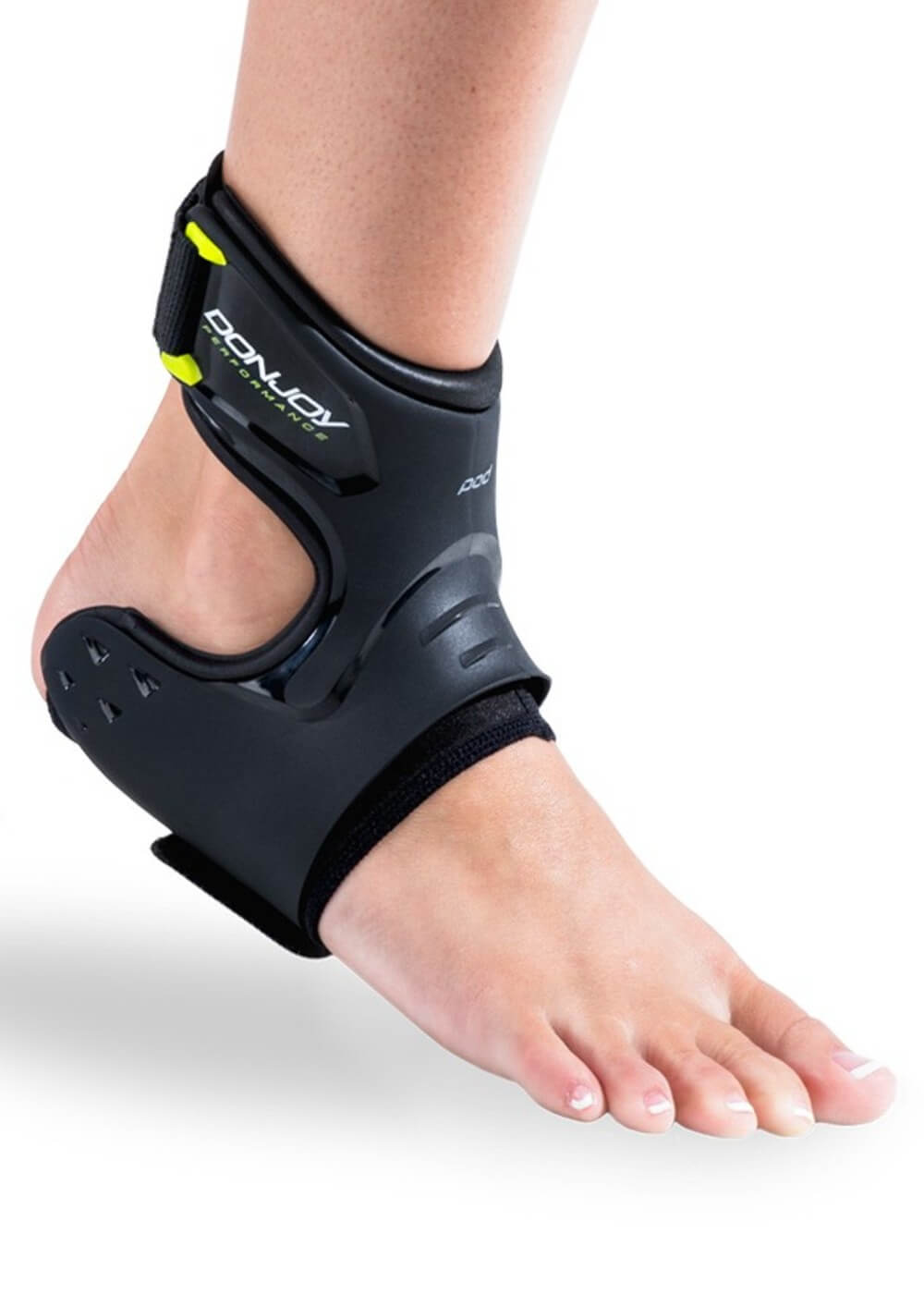
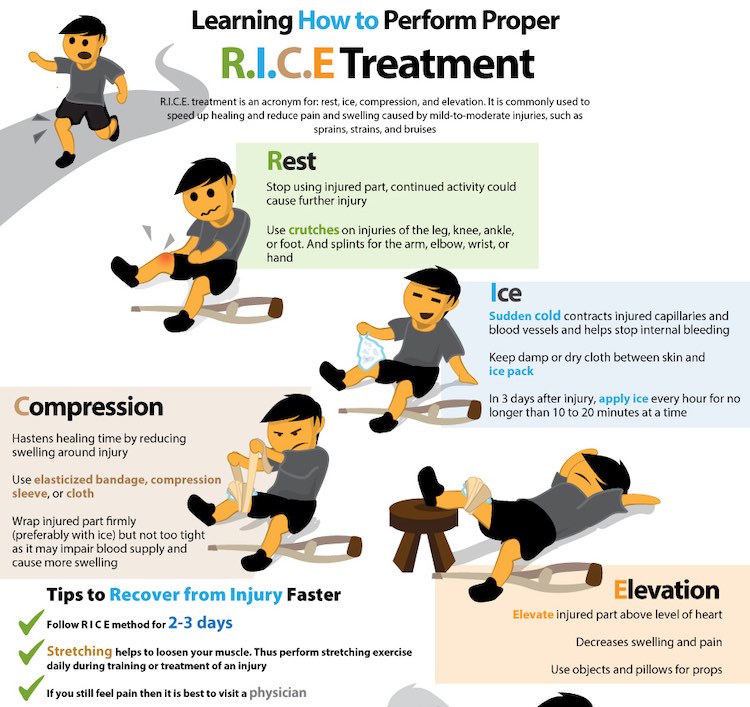
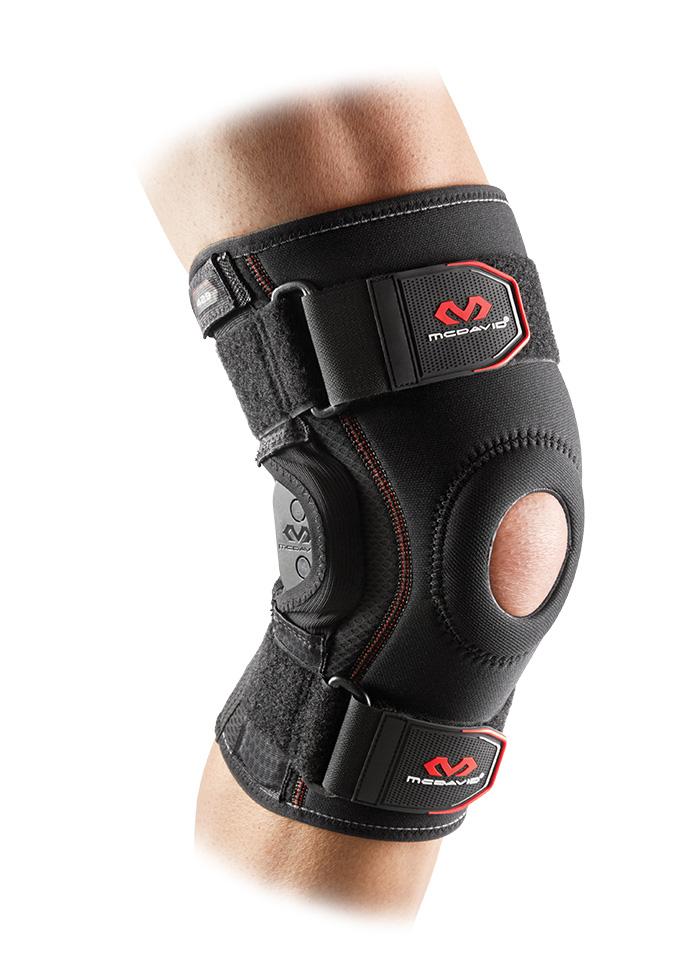
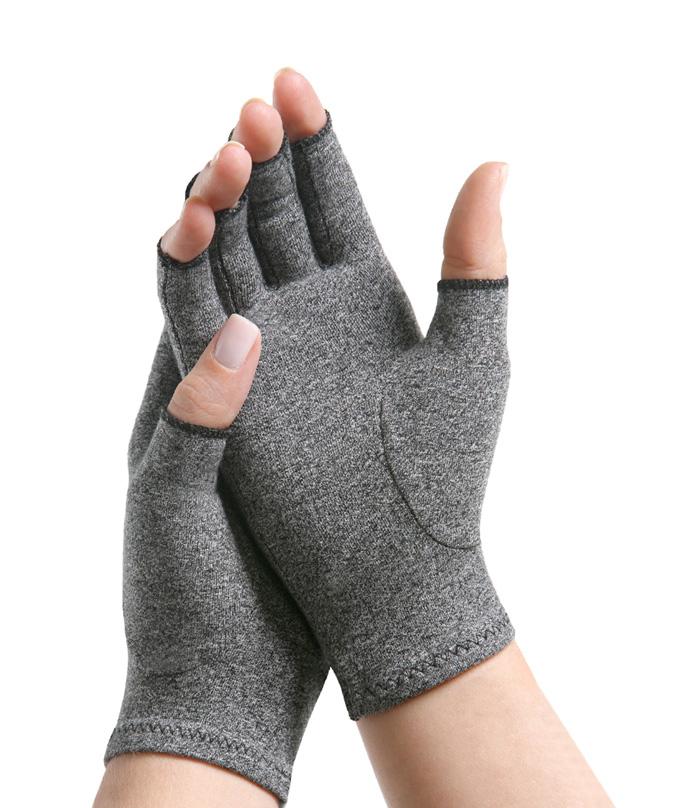
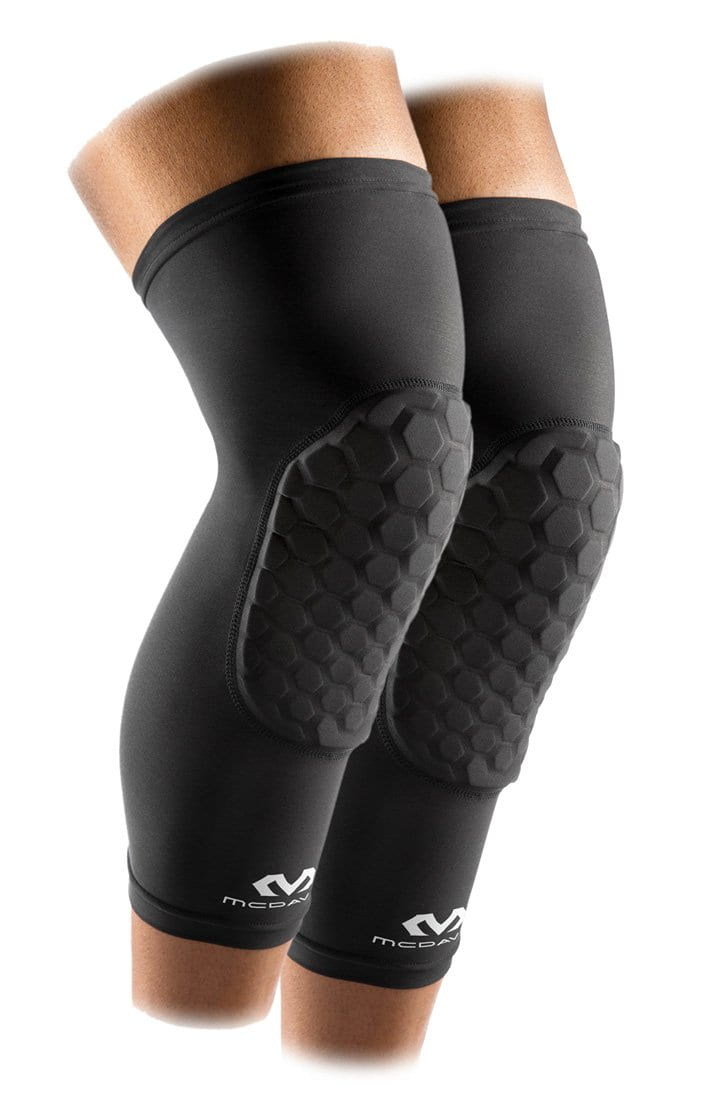
Good info thanks .I believe I will need surgery as the condition is chronic and severe. .Would an orthopedic surgeon be able to fo the ligament reattachments
thanks for sharing amazing blog
Leave a comment